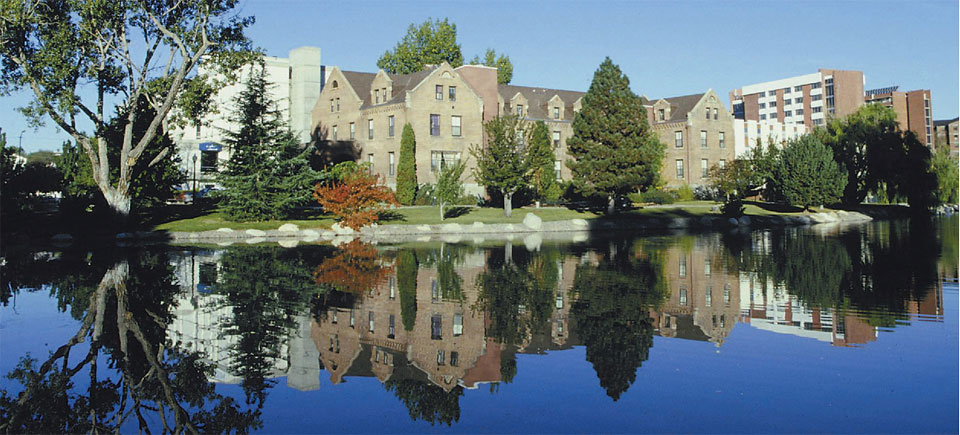Tradition. Relaxation. Recreation. These are students' words when asked about their thoughts on what has been referenced as the jewel of the University of Nevada, Reno's main campus: Manzanita Lake.
One of the University's most iconic landmarks, Manzanita Lake celebrates its centennial anniversary this month. An exhibit presented this month by the University's Special Collections Department on the second floor of the Mathewson-IGT Knowledge Center showcases photos, a timeline of significant moments in the lake's history and commentaries that capture the many attributes of the lake.
"Manzanita Lake is arguably the most beautiful landmark on the University of Nevada, Reno campus," said Betty Glass, Special Collections librarian. "Generations of University students, faculty and staff have enjoyed using the lake or staging campus events along its shores."
The lake has been a site for recreation throughout its history. For many years, people enjoyed ice skating on Manzanita Lake. The Winter Carnival of February 1940 included ice skating demonstrations, and actors Jeanne Crain and William Holden were filmed skating on the lake for the 1948 movie "Apartment for Peggy."
Donnie Curtis, director of Special Collections, said, "The lake is important for the University, especially when the campus was smaller, because it was a central location, and it was the scene of many events, traditions and always a good place to relax. It truly is a spot of beauty and a rare water feature in the middle of a desert environment."
As part of a spring 2011 project for his Introduction to Public History class, taught by Alicia Barber, recent University alumnus Douglas Boedenauer researched an extensive history of the lake and its significance to the campus.
According to Boedenauer, the lake was created when the Orr Irrigation Ditch, an agricultural waterway that pre-dated the University of Nevada, was dammed. The filling of the ditch was made possible by financial assistance from Clarence Mackay, son of Nevada legend, John Mackay.
"I think of tradition," said University senior Nikki Velez. "I think of how the Mackay games used to be held on the lake and that students would come together in that area. It's an iconic place on campus."
Mackay Day was established as a campus tradition to honor the University's benefactor John Mackay.
"Through the years, Mackay Day has staged a variety of events at Manzanita Lake, including a tug-of-war contest between freshmen and sophomores, swimming contests, inner-tube races, raft races and log-rolling contests," said Glass.
Bowen Drewes, a 2008 University alumnus, said, "I have fond memories of the lake; I remember sliding ice chunks off as far as I could across the frozen surface in winter, and wondering why the little island seems to be made out of concrete pipes. I remember enjoying the sunshine on the banks and watching the swans when they chased the ducks and the geese away from their cygnets."
"It's the greenest part of campus," said University junior Lisa Tassiello. "It's very relaxing to sit on the grass, listen to the sounds and just watch the swans. It's a great escape on campus and everyone is welcome."
Manzanita Lake has served as a serene home to many swans, which are iconic figureheads for the lake, on and off since the 1930s.
"I'm from Lake Tahoe and am used to seeing plenty of nature all round me and whenever I walk by the south side of campus, I always say, 'time to see the swans'", said transfer student Nicole Tran. "It's become one of the things I look forward to doing on a daily basis.
Although the swans enjoy a high degree of popularity, they have also been victims of tragic and peculiar misfortunes. In his article, Boedenauer wrote, "On May 8, 1977, two of Manzanita Lake's swans were brutally murdered by an unknown person in a senseless act of animal cruelty. Several months later, Lena, one of two black swan replacements, was killed by a roaming dog. However, these horrible incidences are counterbalanced by new life at Manzanita Lake. In 2010, for example, four cygnets were born to the campus' current pair of swans, Zeus and Olivia."
Manzanita Lake has become a significant part of the University. It is full of history, intrigue and moments that stay in everyone's mind; and although times have changed and many of the activities that were held on the lake are now prohibited, what should be remembered is that the lake has and will always be a site for tradition, relaxation and recreation.
The Manzanita Lake exhibit continues through February 2012 and exhibit hours vary according to the Knowledge Center schedule. All items on display are from archives maintained by the University Special Collections. For more information, visit the Special Collections website or contact Betty Glass at glass@unr.edu or call (775) 682-5668.
About Special Collections
The Special Collections and University Archives Department houses, preserves, and provides access to unique, specialized, and historically significant resources in a variety of formats to support research, teaching and learning at the University of Nevada, Reno. Other researchers and members of the public are welcome to use Special Collections and University Archives materials.
Most of the materials in Special Collections pertain to the history and cultures of Nevada and the Great Basin. University Archives preserves the history of the university in documents, photographs, books, and memorabilia.












